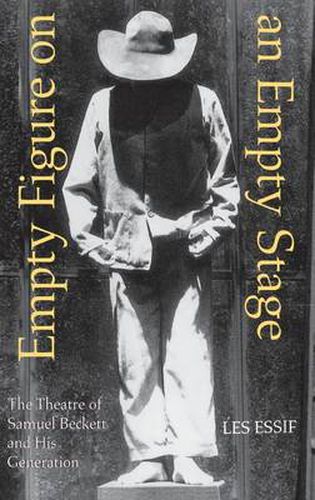Readings Newsletter
Become a Readings Member to make your shopping experience even easier.
Sign in or sign up for free!
You’re not far away from qualifying for FREE standard shipping within Australia
You’ve qualified for FREE standard shipping within Australia
The cart is loading…






This title is printed to order. This book may have been self-published. If so, we cannot guarantee the quality of the content. In the main most books will have gone through the editing process however some may not. We therefore suggest that you be aware of this before ordering this book. If in doubt check either the author or publisher’s details as we are unable to accept any returns unless they are faulty. Please contact us if you have any questions.
This study considers the ways playwrights draw meaning from emptiness. With abundant reference to actual performances of dramatic works, Les Essif examines drama associated with non-realistic movement known as theatre of the absurd, focusing on the ways dramatists create an impression of emptiness not only on the stage but also in the body and mind of the central character. Thus, Essif makes a case for the metadramatic fusion of stage and character. The book begins with a discussion of philosophical, sociocultural, and theatrical implications of emptiness. Bringing together pioneers in theatre phenomenology like Bert O. States and Stanton B. Garner, Jr., with theatrical thinkers like Antonin Artaud and Godon Craig, and socio-aesthetic thinkers like Mikhail Bakhtin and Theodore Adorno, Essif formulates what he calls a metaphysical-phenomenological approach to drama and performance, and he presents a historical and theoretical overview of how empty characters and empty space evolve in Western drama.After an extended examination of Samuel Beckett’s drama and performance, Essif studies works of other dramatists of this generation, primarily from France (Ionesco, Vian, Dubillard, Obaldia), but also from other national cultures of the Western World (Bernhard, Pinter, Stoppard, Handke, Shepard). He supports his thesis with a number of photo illustrations from art history as well as from theatrical performances of the works in question. Within this framework, Essif develops an original theory of hypersubjectivity for drama based on the metadramatic union of space and character. The hypersubjective dramatic character is one that constitutes, in effect, an empty spatial field in its own right. Essif’s approach to drama and performance allows him to challenge much hitherto sacrosanct scholarship regarding the structures of subjectivity, fragmentation, and the marionette-likeness of characters, as well as the themes of death and action. For example, the book challenges the widely held theory of fragmentation in Beckett’s drama by focusing on the paradoxical impression of concentration that accompanies the impression of emptiness.It shifts the focus from language and narrative story back to the primacy of the visual image on Beckett’s stage, arguing that, backgrounded as it is by a singularly undifferentiated image of emptiness, the fragmentation of bodies, space, and language is largely diversionary and illusionary.
$9.00 standard shipping within Australia
FREE standard shipping within Australia for orders over $100.00
Express & International shipping calculated at checkout
This title is printed to order. This book may have been self-published. If so, we cannot guarantee the quality of the content. In the main most books will have gone through the editing process however some may not. We therefore suggest that you be aware of this before ordering this book. If in doubt check either the author or publisher’s details as we are unable to accept any returns unless they are faulty. Please contact us if you have any questions.
This study considers the ways playwrights draw meaning from emptiness. With abundant reference to actual performances of dramatic works, Les Essif examines drama associated with non-realistic movement known as theatre of the absurd, focusing on the ways dramatists create an impression of emptiness not only on the stage but also in the body and mind of the central character. Thus, Essif makes a case for the metadramatic fusion of stage and character. The book begins with a discussion of philosophical, sociocultural, and theatrical implications of emptiness. Bringing together pioneers in theatre phenomenology like Bert O. States and Stanton B. Garner, Jr., with theatrical thinkers like Antonin Artaud and Godon Craig, and socio-aesthetic thinkers like Mikhail Bakhtin and Theodore Adorno, Essif formulates what he calls a metaphysical-phenomenological approach to drama and performance, and he presents a historical and theoretical overview of how empty characters and empty space evolve in Western drama.After an extended examination of Samuel Beckett’s drama and performance, Essif studies works of other dramatists of this generation, primarily from France (Ionesco, Vian, Dubillard, Obaldia), but also from other national cultures of the Western World (Bernhard, Pinter, Stoppard, Handke, Shepard). He supports his thesis with a number of photo illustrations from art history as well as from theatrical performances of the works in question. Within this framework, Essif develops an original theory of hypersubjectivity for drama based on the metadramatic union of space and character. The hypersubjective dramatic character is one that constitutes, in effect, an empty spatial field in its own right. Essif’s approach to drama and performance allows him to challenge much hitherto sacrosanct scholarship regarding the structures of subjectivity, fragmentation, and the marionette-likeness of characters, as well as the themes of death and action. For example, the book challenges the widely held theory of fragmentation in Beckett’s drama by focusing on the paradoxical impression of concentration that accompanies the impression of emptiness.It shifts the focus from language and narrative story back to the primacy of the visual image on Beckett’s stage, arguing that, backgrounded as it is by a singularly undifferentiated image of emptiness, the fragmentation of bodies, space, and language is largely diversionary and illusionary.